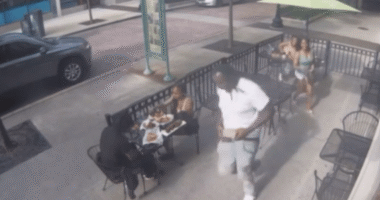CLAMBERING down into the claustrophobic gloom of the first transatlantic narco-submarine in Europe, it feels like I’ve entered a floating coffin.
A fibreglass body resonates with my knock in the Amazon jungle, a creation of drug lords. The control panel, adorned with a few rudimentary dials and a rusting key in the ignition, gives an eerie ambiance to the scene.




In a daring feat, three desperados managed to navigate this primitive contraption on a nearly suicidal 28-day voyage from the coca fields of South America to the untamed Galician coast of Spain.
Journeying across 4,000 miles, packed tightly behind the sub’s steering wheel was its precious payload — three tonnes of the finest Colombian cocaine, valued at over £120 million.
Spanish police drugs chief Alberto Morales, 49, tells me: “They had GPS, but it was a very high risk.
“Merchant vessels crossing the Atlantic can’t detect a submersible.”
Yet in the wake of this deathtrap vessel — nicknamed Che — a fleet of narco-subs sailing to Spain’s so-called Cocaine Coast of Galicia has followed.
Sitting at the helm of the 65ft craft today — with soot from its diesel engine caking my hands — it is clear there would only have been enough room for one of the crew to sit upright comfortably.
Indeed, there was no space onboard Che for a toilet.
Instead, the men relieved themselves out of the sub’s hatch above their heads, when surfaced, or resorted to using plastic bags.
Their rations were low-bulk items such as energy bars, biscuits and tins of sardines.
Yet as 34-year-old skipper Agustin Alvarez — an ex-champion boxer from Galicia — and two Ecuadorean maintenance crew battled perilous Atlantic currents, their mission had already been fatally compromised.
Britain’s National Crime Agency had been tracking the sub.
Perhaps satellite telephone calls made by its exhausted crew were intercepted or there had been a tip-off from a cartel snitch.
Speaking at his Madrid HQ, Superintendent Morales added: “British intelligence always helps us to manage this type of operation.
“We don’t ask where the intel comes from.”
When Che finally made it to the boulder-strewn shores of Galicia in north west Spain, its drugs were seized and the men later jailed.
Now a trophy in a car park at Spain’s police academy in Avila, 66 miles west of Madrid, you might think its doomed 2019 crossing — and the loss of its white gold hoard — would see similar ventures scuppered.
Yet eight of the vessels have now been discovered, including one last month intercepted by Portuguese cops 400 miles south of the Azores islands heading for Europe.
It was carrying nearly seven tonnes of cocaine — and the NCA was again involved in the operation.
While Che was the first trans- atlantic sub to be discovered, it is highly likely others had already made the treacherous journey.
Police believe narco-subs may have been attempting the Atlantic crossing undetected for the past 20 years.
Some sources suggest as many as one sub a month is undertaking the trip.
Superintendent Morales’ estimate is that it is no more than five a year.



In June 2024 one of the home-made subs was spotted by a plane while moving down the Spanish coast, then heading back towards South America before contact was lost.
It is believed the craft unloaded its drugs haul in the Bay of Biscay.
One sub was even stopped by the Colombian Navy in November on what they believe is a new smuggling route to Australia, while drug trafficker Laureano Oubina claims there is a narco-sub graveyard off Spain’s Canary Islands.
The vessels are said to have unloaded their drugs on to waiting speed boats before being sunk.
What is certain is that Spain remains the gateway for much of the cocaine heading to Britain and the rest of Europe.
Now, with US President Donald Trump declaring eight of the most menacing Latin American cartels as terrorist organisations, Spanish cops fear Europe may increasingly be targeted by the ruthless narcos.
The new rules mean US prosecutors will be able to freeze cartel assets and invoke travel bans.
Superintendent Morales revealed: “The rules of engagement will change 100 per cent.
“And the cartels will increase the quantity of drugs that they are going to send to Europe.”
Recent evidence suggests the ultra-violence of the warring Mexican drug gangs is fast arriving in Spain.
‘DRUG MOTORWAY’
Astonishing footage obtained by The Sun shows assault rifle-toting, balaclava-clad narcos offloading what is believed to be hashish at an estuary near the south-western city of Huelva.
Police were moved to say of the disturbing images, which emerged in February: “This is not a movie.”
Meanwhile, the Guadalquivir river — which passes through the southern tourist city of Seville — is fast gaining a reputation as the “new drug motorway” for Mafia-style groups smuggling cannabis resin and cocaine.
Spanish police confirmed to me that British mobsters — who have long cherished their place in the sun amid the fleshpots of Marbella — enjoy a slice of the narco action.
But the big cocaine players in Spain are the Mocro mafia — gangsters of Moroccan descent — and Albanian organised criminals.
They move huge shipments through container ports at Algeciras, Valencia and Barcelona, sometimes relying on corrupt workers there.
Yet the cartels increasingly see the home-made narco-subs as a surer way for Britain’s favourite party drug to reach the shores of Europe.
For the craft — technically semi-submersibles with a portion of the cabin poking above the water — are difficult for law enforcement to spot.
Sun photographer Dan Charity and I joined customs chief Javier Amaro Galvez, 49, and a ten-strong crew on the Halcon patrol ship scouring the Cocaine Coast.
Narco-subs are difficult to detect with ships’ radar.
Instead, the crew hope thermal-imaging equipment onboard will pick up the heat of their engines amid the ocean’s vastness.


Stored on the ship are Heckler & Koch MP5 submachine guns that can be issued if the narcos are encountered and things turn ugly.
Galicia’s rocky peninsulas and secret coves have long been a smugglers’ paradise.
Javier, head of Vigo port for Spain’s Customs Control Force, explained that the Latin American cartels team up with the Galicians for their seafaring ability and local knowledge.
“If cocaine is coming through a port, the Albanians can handle it themselves,” he revealed.
“But if they want to land drugs along this coast, they need the Galicians.
“A person who has grown up here and been on the sea since he was a young child knows how the sea behaves.
“There’s a long tradition of smuggling here.”
Javier — from Spain’s tax agency — says the first narco-sub discovered in Galicia was in 2006.
Intelligence suggested it did not come from South America.
“It was thought to be a dummy-run vessel with the idea being it would leave the Galician coast, head out to a boat at sea and bring the drugs back to land,” Javier explained.
The Halcon’s captain Sara Portela, 29, points to a boulder-strewn headland north of Vigo where Che was sunk by its crew a few feet from shore.
Her boss, Javier, revealed: “The smugglers’ original plan had been to drop the drugs off at sea so that they could then be brought to land by semi-rigid boats.
“But because of bad weather that day, the plans were aborted. The men on that ship were arrested and brought to justice.”
In March 2023, another narco-sub was found further north in the Ria de Arousa estuary.
Javier said its drugs haul had already been offloaded and the smugglers then sank the craft.
In January, an empty sub was found in the Camarinas-Muxia estuary in Galicia after arriving from South America.
‘TAINT OUR REGION’
Customs boss Javier added: “These vessels are going to be employed more and more by the drug smugglers because they are a potent weapon.
“They’re very difficult to detect, so we need more resources, such as flights and semi-rigid boats.”
Back on dry land, I met Spanish author and crime reporter Javier Romero, 44, whose book on Che — Operation Black Tide — was turned into an Amazon Prime drama series.
Quizzed over thermal imaging techniques that might snare a sub, he said: “When they catch one on the high seas, let’s talk.”
Several sources have told Javier that narco-subs have been coming to Spain since 1998 and that the going rate for the construction for one of the vessels is 300,000 euros.

The author said of the Cocaine Coast trafficking clans: “They had long been involved in cigarette smuggling, then moved into hashish and, later, cocaine.
“Say 15 per cent of cocaine stays here.
“The rest is sold on, mainly to the Mocro mafia and the Albanians.”
Much of the powder will eventually end up being sold in Britain.
A 2023 study showed the UK has the second-highest rate of cocaine use in the world, behind only Australia.
One in 40 British adults takes the class A drug.
At a palatial mansion once owned by feared narco Manuel Charlin, overlooking the Cocaine Coast near Coron, I met anti-drugs campaigner Fernando Alonso.
The manager of charity The Galician Anti-Drugs Foundation revealed: “Charlin was a cruel, inhumane man who used violence on his rivals.”
Staring out towards the Atlantic, he said: “The nickname Cocaine Coast makes me very sad and causes me shame.
“I want Galicia to be known for rejecting drug trafficking and the miserable people who taint our region by offloading their drugs here.”
The 58-year-old added that the narco-subs arriving on nearby shores seem “like a science fiction film”, before adding: “But it’s not, unfortunately — it’s reality.”
Fernando believes rival mafia-style groups could soon unleash a spree of savage blood-letting in Galicia.
“We’re seeing more weapons being confiscated in police anti-drug operations,” he added.
“Cocaine destroys everything it touches.”



Unlock even more award-winning articles as The Sun launches brand new membership programme – Sun Club.

















